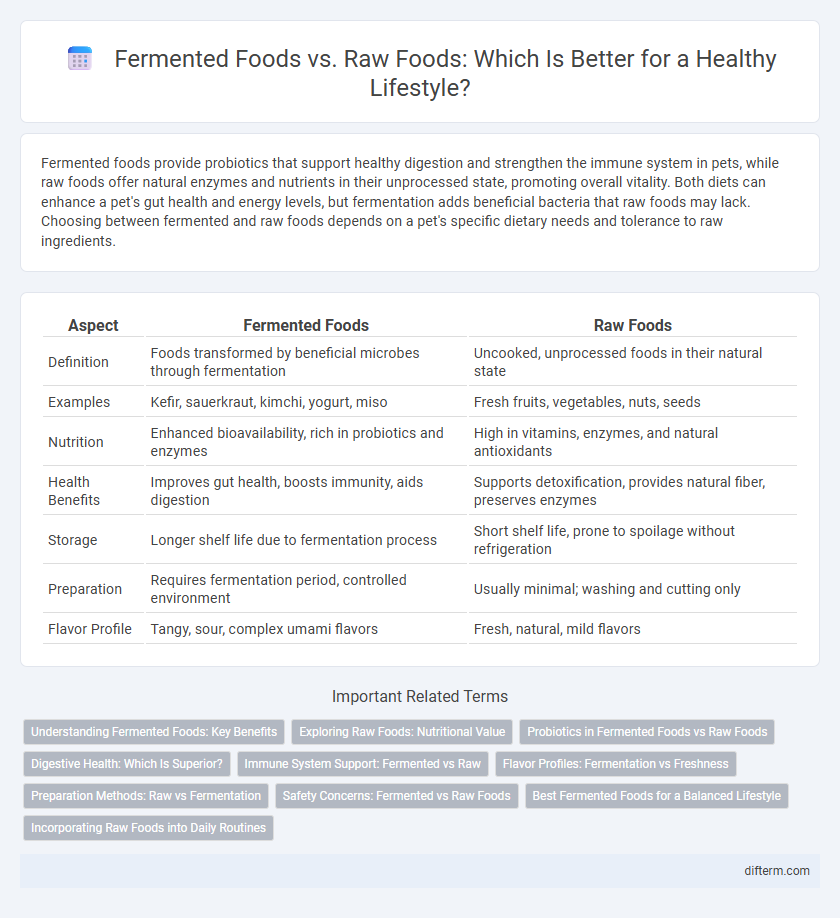Fermented foods provide probiotics that support healthy digestion and strengthen the immune system in pets, while raw foods offer natural enzymes and nutrients in their unprocessed state, promoting overall vitality. Both diets can enhance a pet's gut health and energy levels, but fermentation adds beneficial bacteria that raw foods may lack. Choosing between fermented and raw foods depends on a pet's specific dietary needs and tolerance to raw ingredients.
Table of Comparison
| Aspect | Fermented Foods | Raw Foods |
|---|---|---|
| Definition | Foods transformed by beneficial microbes through fermentation | Uncooked, unprocessed foods in their natural state |
| Examples | Kefir, sauerkraut, kimchi, yogurt, miso | Fresh fruits, vegetables, nuts, seeds |
| Nutrition | Enhanced bioavailability, rich in probiotics and enzymes | High in vitamins, enzymes, and natural antioxidants |
| Health Benefits | Improves gut health, boosts immunity, aids digestion | Supports detoxification, provides natural fiber, preserves enzymes |
| Storage | Longer shelf life due to fermentation process | Short shelf life, prone to spoilage without refrigeration |
| Preparation | Requires fermentation period, controlled environment | Usually minimal; washing and cutting only |
| Flavor Profile | Tangy, sour, complex umami flavors | Fresh, natural, mild flavors |
Understanding Fermented Foods: Key Benefits
Fermented foods boost gut health by promoting beneficial probiotics, enhancing digestion, and strengthening the immune system. Unlike raw foods, fermentation increases nutrient bioavailability and introduces unique enzymes that aid metabolic processes. Regular consumption supports mental well-being through the gut-brain axis, making fermented foods a vital addition to balanced diets.
Exploring Raw Foods: Nutritional Value
Raw foods retain maximum natural enzymes, vitamins, and minerals, supporting improved digestion and enhanced nutrient absorption. Unlike fermented foods, which undergo microbial transformation, raw foods provide unaltered phytochemicals and antioxidants crucial for immune function and cellular health. Incorporating fresh fruits, vegetables, nuts, and seeds in their raw form ensures optimal intake of fiber, vitamin C, and folate essential for a balanced lifestyle.
Probiotics in Fermented Foods vs Raw Foods
Fermented foods such as yogurt, kimchi, and sauerkraut contain live probiotics that actively enhance gut microbiota diversity and improve digestion. Raw foods, while rich in natural enzymes and nutrients, typically lack the concentrated probiotic cultures found in fermented products. The fermentation process promotes beneficial bacteria proliferation, making fermented foods a superior source of probiotics for supporting gut health and immune function.
Digestive Health: Which Is Superior?
Fermented foods contain beneficial probiotics that enhance gut microbiota diversity and improve digestion more effectively than raw foods. Raw foods provide enzymes and fiber supporting digestive processes but lack the live cultures essential for gut health found in fermented options like yogurt, kimchi, and sauerkraut. Consuming fermented foods consistently has been linked to reduced inflammation, improved nutrient absorption, and better overall digestive health outcomes.
Immune System Support: Fermented vs Raw
Fermented foods like yogurt and kimchi contain probiotics that enhance gut microbiota diversity, boosting the immune system's ability to fight infections. Raw foods retain vital enzymes and antioxidants that support immune function by reducing oxidative stress and inflammation. Incorporating both fermented and raw foods optimizes immune resilience through complementary mechanisms of probiotic support and nutrient preservation.
Flavor Profiles: Fermentation vs Freshness
Fermented foods offer complex, tangy, and umami-rich flavor profiles produced by natural microbial activity, enhancing depth and savoriness in dishes. Raw foods provide bright, crisp, and vibrant freshness, preserving natural textures and subtle nuances of the original ingredients. Flavor preferences depend on whether one values the bold intensity of fermentation or the clean, refreshing taste of raw produce.
Preparation Methods: Raw vs Fermentation
Fermented foods undergo controlled microbial transformation, enhancing nutrient bioavailability and introducing beneficial probiotics that support gut health. In contrast, raw foods are consumed in their natural state, preserving original enzymes and heat-sensitive nutrients without microbial alteration. Preparation of fermented foods requires time, specific bacterial cultures, and controlled conditions, whereas raw foods demand minimal processing, emphasizing freshness and immediate consumption.
Safety Concerns: Fermented vs Raw Foods
Fermented foods undergo microbial transformation that enhances safety by reducing harmful pathogens and preserving nutrients, whereas raw foods carry a higher risk of contamination due to lack of processing. The controlled fermentation environment promotes beneficial bacteria growth, which can outcompete and inhibit dangerous microbes. Proper handling and storage remain crucial for both food types to minimize foodborne illness risks.
Best Fermented Foods for a Balanced Lifestyle
Kimchi, sauerkraut, and kefir are among the best fermented foods for a balanced lifestyle due to their high probiotic content, which supports gut health and boosts the immune system. These foods contain beneficial bacteria like Lactobacillus that aid digestion and improve nutrient absorption compared to raw foods. Incorporating diverse fermented options daily promotes a healthy microbiome and enhances overall well-being.
Incorporating Raw Foods into Daily Routines
Incorporating raw foods into daily routines enhances nutrient intake by preserving enzymes and vitamins often lost during cooking. Fresh fruits, vegetables, nuts, and seeds provide essential antioxidants and fiber that support digestion and immunity. Balancing raw foods with fermented options maximizes gut health through complementary probiotics and prebiotics.
Fermented foods vs Raw foods Infographic

 difterm.com
difterm.com